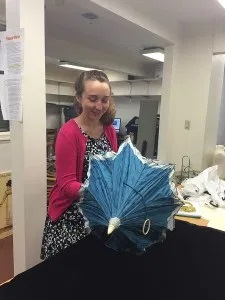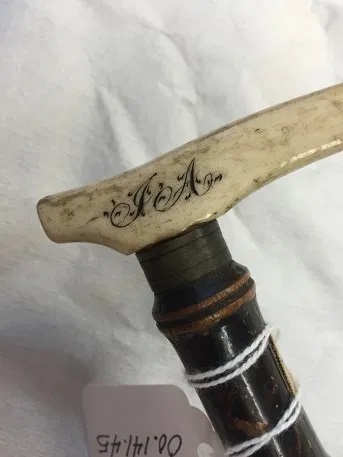Summer Research Report: Rosalie Hooper
Graduate students have received Decorative Arts Trust summer research grants for a variety of projects, studying objects as varied knife boxes, schrimshaw, furniture (of course), and Tiffany stained glass. This year’s cohort of summer research grant recipients yielded similarly diverse and interesting topics, including a first for the Trust: a project about umbrellas.

Rosalie Hooper inspecting an America-made umbrella at the Shippensburg University Fashion Archive and Museum. Photo courtesy Rosalie Hooper.
Rosalie Hooper, a second-year graduate fellow in the Winterthur Program in American Material Culture with the University of Delaware, is a native Pennsylvanian and came to her love of the decorative arts through her experience as an interpreter at the Peter Wentz Farmstead in Landsdale and as a storyteller in Philadelphia. She has also created educational programs about Pennsylvania Hall and the abolitionist movement for the National Constitution Center.
While reading John Crowley’s The Invention of Comfort during her first semester of graduate school, Rosalie came across mentions of the umbrella-making industry, and then started noticing them everywhere in the decorative arts–depicted in prints and cartoons, Chinese export porcelain, and even on school girl embroidery. They were a common part of everyday American life throughout the 19th century, and during the 1850s were produced in vast quantities (the Wright Brothers & Co. of Philadelphia claimed to produce 700,000 a year). Despite their ubiquity—and presence in many museum collections, they remain minimally studied and understood. The one museum dedicated to the topic, the Museo dell’Ombrello in Gignese, Italy, does not focus on umbrellas and parasols of American manufacture, and the few scholarly works on the topic focus on European goods as well. As objects, umbrellas and parasols speak to Rosalie’s scholarly interests in race, gender and international exchange.
In her report of her summer activities Rosalie told us of her travels:
“While the collection of Winterthur Museum and Library includes many documents, images, and objects that contextualize the use and manufacture of umbrellas and parasols, there are few umbrellas or parasols in the collection from my period of interest. I had to look beyond local collections to try and find a representative sampling of antebellum umbrellas and parasols. While I have not been able to find a single definitive collection of American umbrellas and parasols, many museums, historic houses, and historical societies have collections that include a few of these items. Identifying and visiting collections to measure, document, and closely study relevant umbrellas and parasols is a central part of my thesis research.”
“Generous funding from the Decorative Arts Trust allowed me to visit the New Bedford Whaling Museum, which has a large group of over 80 umbrellas and parasols in their collection. Many of these objects have ribs that were made using baleen and ferrules, handles and tips made of whalebone, hallmarks of production during the first half of the nineteenth century. The large collection held by the New Bedford Whaling Museum allowed me to compare and contrast features on different parasols and umbrellas side by side as well as closely examining each parasol and umbrella in its own right. While each object I studied helped me to develop the visual vocabulary and connoisseurship skills necessary to truly understand these objects, I was especially excited to find two examples of personalized engraved handles. Umbrellas and parasols are rarely personalized and early producers did not often mark their work, making the discovery of marked pieces quite remarkable. I look forward to using the Museum’s provenance files and further documentary research to learn more about these individuals and perhaps better understand why they chose to mark their umbrellas.”
“The experience I gained from handling the umbrellas and parasols of the New Bedford Whaling Museum generated questions about the manufacturing processes and the patterns of use of umbrellas and parasols in antebellum America that I cannot yet answer. Thanks to the funding I received from the Decorative Arts Trust, however, I am much further in my understanding of these complicated objects.”
We look forward to hearing more about Rosalie’s project in the upcoming months. Summer research grants such as the one Rosalie received are awarded each year to graduate students working on a Master’s thesis of PhD dissertation in a field related to the decorative arts. Applications can be downloaded from the Trust’s website, and submitted via e-mail or on-line, and are due by April 30 each year. Questions may be directed to the Trust by phone or e-mail.
About The Decorative Arts Trust Bulletin
Formerly known as the "blog,” the Bulletin features new research and scholarship, travelogues, book reviews, and museum and gallery exhibitions. The Bulletin complements The Magazine of the Decorative Arts Trust, our biannual members publication.









